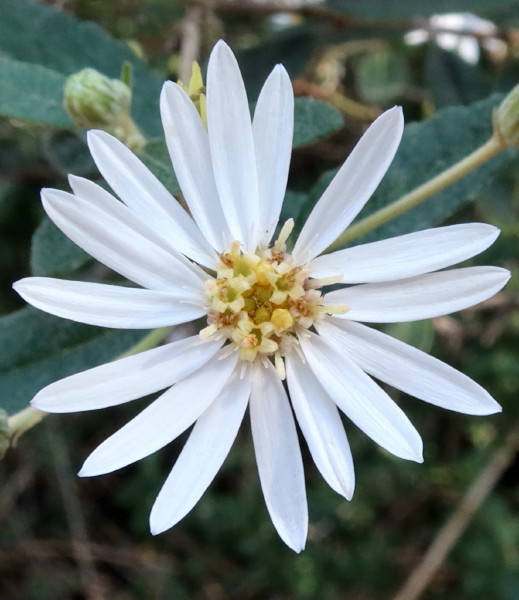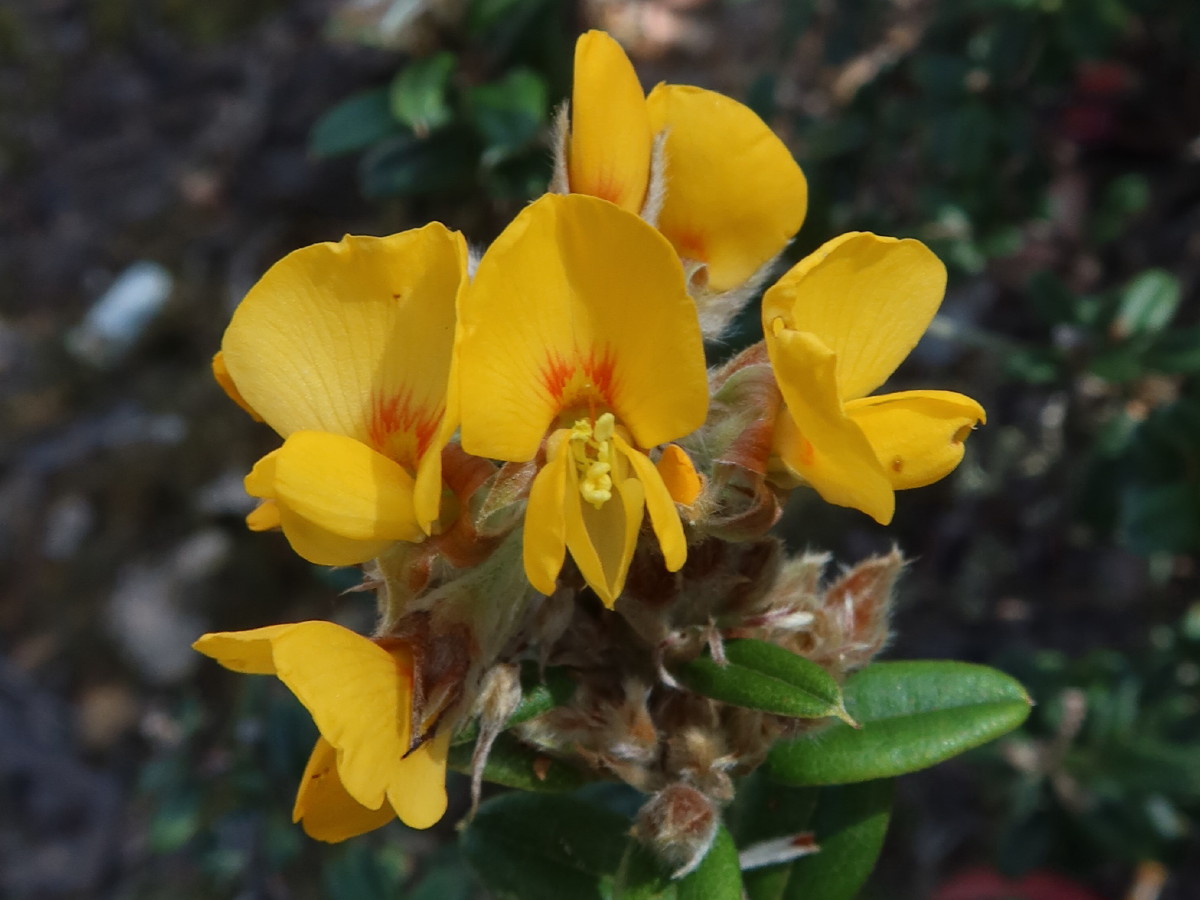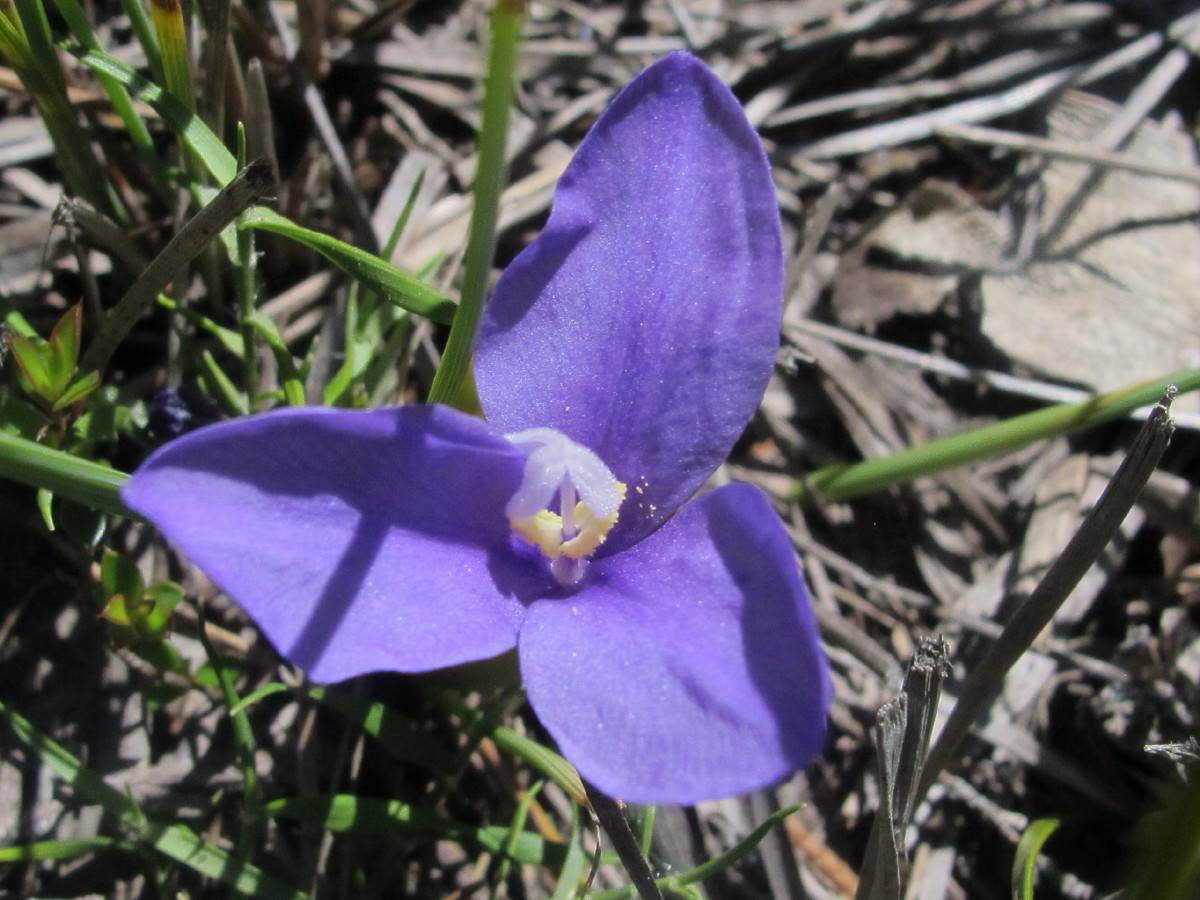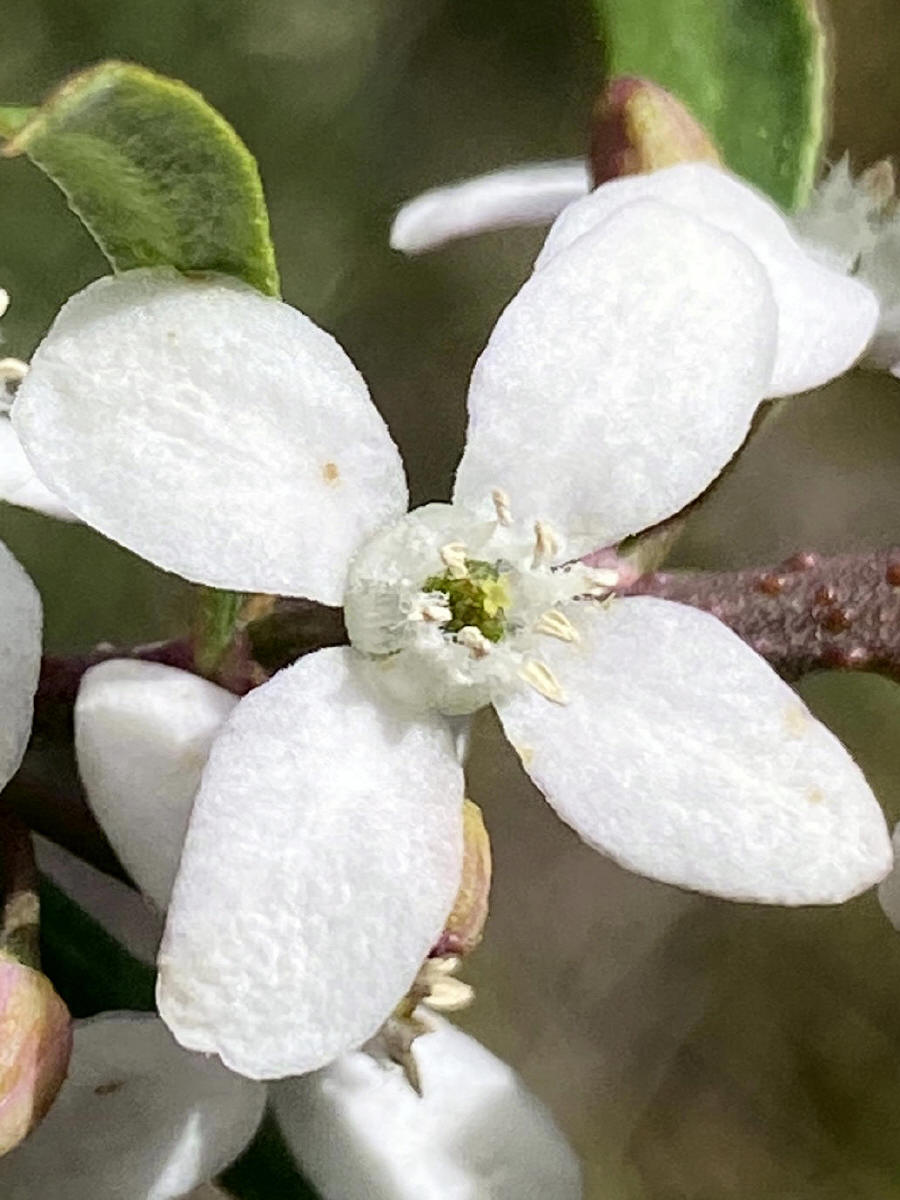Spring M-P
Looking at the photographs To view the photographs, click on the species image to enlarge it,
then use the side arrows to page through images of the flowers, buds, fruit, leaves, foliage and plant(s) in the wild etc.
Viewing the meaning of botanical words To view the meaning of botanical words, hold the cursor on the blue word and the meaning will appear in a text box. On phones, turn to landscape to view all.
Based on Debenham C’s, The Language of Botany, A Publication of The Society for Growing Australian Plants, Chipping Norton NSW, c.1962.
Olearia phlogopappa
Botanical Name: Olearia phlogopappa
Commonly Called: Dusty daisybush
Botanical Family: Asteraceae
Grows: The erect small shrubs grow 0.5 to 2.0m high by 0.5 to 1m wide.
Foliage: The alternate, variable, narrow elliptical 0.8 to 4cm and occasionally up to 6.5cm long leaves are grey to dark green on top and densely hairy under with entire or irregularly round toothed edges. They have a short petiole and their apex is blunt or acute.
Flowers: The daisy form, occasionally blue, mauve or pink but usually white, flowers grow in dense terminal clusters on the side branches. The very numerous flowerheads are stalked with the peduncle typically ebracteate and longer than the leaves but shorter and more or less leafier in some variants. They are often solitary and terminal at the ends of short axillary branches along the length of the stem and sometimes in few-flowered terminal and axillary panicles. The turbinate, 4 to 5mm long involucre have lanceolate, subacute and tomentose phyllaries sometimes with purplish edges and tips. These flowerheads are about 2cm diameter with 20 to 26 usually white but occasionally blue, mauve or purplish florets of which about half are ligulate.
Flowering Season: The flowers appear in spring and continue into early summer.
Fruit: The fruit are about 2.5mm long, shortly pubescent achenes. Their pappus, about 5mm long, have long bristles surrounded by an outer row of shorter ones.
Habitat/distribution: This beautiful erect plant is found wide spread from coast to mountains in both dry and wet sclerophyll forests. It is also indigenous in Vic and NSW.
Where found: Cradle Mountain Lake St Claire, Hartz Mountain, Mt Field and Tasman National Parks; Murrays Track, Bruny Island; Bluff River Gorge, Buckland; First Basin; Knocklofty Reserve, West Hobart; Liawenee, Lake Augusta and Lake Ada areas; Orford Thumbs, Orford; Peter Murrell, Blackmans Bay; Platform Peak, Tarkine, kunanyi/Wellington Park, St Helens Conservation Area and Upper Mersey and Forth Reserves; Heritage Forest Tasmanian Native Garden, Mowbray; Royal Tasmanian Botanical Gardens; Tasmanian Bushland Garden, Buckland; and The Tasmanian Arboretum, Eugenana; Nubena, Port Arthur and several locations around the south west coast, also many home gardens.
Other notes: A beautiful small shrub with grey leaves and often masses of white, blue, mauve or purplish daisy flowers, it is an ideal easily trimmed low hedge species. It grows best in well-drained moist soil in full sun, but may not flower as well in part shade. It may be propagated from tip cuttings or seed. Some commercial nurseries may have good colour forms available.
Oxylobium ellipticum
Botanical Name: Oxylobium ellipticum
Commonly Called: Golden shaggypea
Botanical Family: Fabaceae
Grows: The shrubs grow 1 to 2.5m high by 1 to 2m wide.
Foliage: The elliptical, 1 to 4cm long leaves are dark green on top and grey or rusty hairy under.
Flowers: The pea form flowers grow in corymbose terminal racemes, including on short lateral branches. Their pedicels are shorter than the calyx and the linear bracteoles are caducous. The about 7mm long sepals are villous. The approximately 10mm wide, bright orange-yellow standard is longer than the calyx.
Flowering Season: Flowers appear in spring and into early summer.
Fruit: The fruit is a brown, hairy, up to 8mm long capsule enclosing black, shiny, hard seed.
Habitat/distribution: This beautiful erect plant is found in moist, rocky woodlands and alpine areas up to 1,200m where dwarf forms are found. It is also indigenous in Vic and NSW.
Where found: Cradle Mountain Lake St Claire, Hartz Mountain, Mt Field and Tasman National Parks; Bruny Island; Bluff River Gorge, Buckland; Knocklofty Reserve, West Hobart; Orford Thumbs, Orford; Peter Murrell, Blackmans Bay; Platform Peak, Tarkine, Tolosa Park and kunanyi/Wellington Park Reserves; Heritage Forest Tasmanian Native Garden, Mowbray; Royal Tasmanian Botanical Gardens; Tasmanian Bushland Garden, Buckland; and The Tasmanian Arboretum, Eugenana; Nubena, Port Arthur and several locations around the south west coast, also many home gardens.
Other notes: A beautiful small shrub with nitrogen fixing nodules on its roots, it is an ideal revegetation species. The lower growing alpine form could be mass planted for a brilliant spring flower display. Grow in well drained moist soil in full sun. It may be propagated from cuttings and scarified seed.
Patersonia fragilis
Botanical Name: Patersonia fragilis
Commonly Called: Short purpleflag
Botanical Family: Iridaceae
Grows: The clumps grow 10 to 40cm high by 30 to 40cm wide
Foliage: The firm leaves are narrow, sheathing, ridged and linear. They are dull green/blue to green, 20 to 40cm long.
Flowers: The flowers have 3 conspicuous rounded blue/mauve perianth segments, enclosed in brown terminal bracts on stems shorter than the leaves.
Flowering Season: Flowers appear in late spring and into summer.
Fruit: The fruit is a 3-celled capsule.
Habitat/distribution: The beautiful small clumping plant is found in moist coastal heaths. It also grows in SA, Vic and NSW.
Where found: Strahan, Queenstown, Birchs River Plains and many other places in the west; King, Three Hummock, Furneaux and Bruny Islands; Georgetown, Bridport, St Helens area and many locations in the north east; Freycinet, Forrestier and Tasman Peninsulas and near Orford; Lindisfarne, Longley, near Geeveston, near Hastings Caves and many other places in the south east; Heritage Forest Tasmanian Native Garden; Royal Tasmanian Botanical Gardens; Tasmanian Bushland Garden, Buckland; and The Tasmanian Arboretum, Eugenana; also many home gardens.
Other notes: Can be differentiated from P. occidentalis by its smaller growth habit, with narrower leaves and flower stems shorter than the leaves. The flower bracts contain many flowers that each last about one day. Grow in well drained moist soil in full sun.
Philotheca virgata
Botanical Name: Philotheca virgata
Commonly Called: Twiggy waxflower
Botanical Family: Rutaceae
Grows: A twiggy, small to medium shrub growing 0.5 to 2.5m high by 0.5 to 2m wide.
Foliage: The branchlets are glabrous and glandular tuberculate. The rather crowded, thinly textured, discolorous, aromatic leaves, 1 to 2.5cm long by 2.0 to 5.5 and up to 8mm wide, are elliptical or obovate to obcuneate in shape and dotted with many small oil glands. The upper surface is almost shiny and dark green while the lower surface is paler. The edges are glandular-crenate and slightly recurved, and the apex is shortly mucronate.
Flowers: The axillary inflorescences, with no obvious peduncle, have 1 to 3 flower clusters of 4 or 5 flowers. The small broadly triangular sepals of the flowers are about 1mm long. These white to pale pink flowers have 4 or 5, 4 to 6mm long, broadly elliptical petals. The stamen’s are flattened and ciliolate then abruptly narrow toward the apex, while the anthers are minutely apiculate.
Flowering Season: The flowers may appear in mid autumn and continue through winter, spring and early summer and sometimes to late summer.
Fruit: The fruit is a capsule with two cells, each enclosing a dehiscent, shortly-beaked seed.
Habitat/distribution: This shrub is common in western Tasmania and occasionally some locations on the east, south east and southern coasts. It is also found in NSW and Vic
Where found: It may be found in a variety of habitats, often on well-drained rocky substrates in heathy areas, Eucalyptus woodlands and on rainforest margins. It is common in western Tasmania and isolated locations on the east coast from St Helens to Scamander; Freycinet Peninsula; and areas between the Huon River and D’Entrancasteaux Channel.
Other notes: The distinguishing features are fewer glands than Philotheca verrucosa. This is a hardy plant for well-drained soils in part shade. Tip pruning after fruiting enhances the plant. It may be propagated from cuttings.
Pimelea drupacea
Botanical Name: Pimelea drupacea
Commonly Called: Cherry riceflower
Botanical Family: Thymelaeaceae
Grows: An open shrub growing 1 to 3m high by 0.5 to 1m wide.
Foliage: The leaves are arranged in pairs, elliptical in shape, green upper surface, slightly hairy undersurface with prominent veins.
Flowers: The small white/cream terminal flower clusters which may appear to be axillary because of the shortness of branchlet, have 2 leaf-like bracts and 2 central orange stamens. As the flowers mature they tend to develop a pink throat.
Flowering Season: The flowers appear in late spring.
Fruit: The fruit matures from reddish to a shiny ovoid black drupe.
Habitat/distribution: This shrub is widespread and common as understorey in wet sclerophyll forests. It is also found in Victoria
Where found: Wide spread in wet sclerophyll; throughout the south west, west, north west, north east and south east; Maria, Bruny and Bass Strait Islands; Cradle Mountain and Lake St Claire, Hartz Mountain and Tasman NPs; Wellington Park; Richardsons Road near High Yellow Bluff and MacGregor Road, Forestier Peninsula.
Other notes: Black shiny, ovoid fruit on plant in wet forests. A hardy plant for moist locations in part shade to full sun. Tip pruning after fruiting enhances the plant. The black shiny fruit attracts birds.
E indicates an endemic species and links to the relevant endemic page
- Acacia axillaris Sp E
- Acacia dealbata Sp
- Acacia derwentiana Sp E
- Acacia genistifolia Sp
- Acacia gunnii Sp
- Acacia leprosa Sp
- Acacia melanoxylon Sp
- Acacia mucronata subsp. dependens Sp E
- Acacia mucronata subsp. longifolia Sp
- Acacia mucronata subsp. mucronata Sp E
- Acacia verticillata Sp
- Acrothamnus hookeri Sp
- Ajuga australis Sp
- Almaleea subumbellata Sp
- Alyxia buxifolia Sp
- Amperea xiphoclada Sp
- Anodopetalum biglandulosum Sp E
- Anopterus glandulosus Sp E
- Aotus ericoides Sp
- Aristotelia peduncularis Sp E
- Arthropodium strictum Sp
- Athrotaxis cupressoides Sp E
- Athrotaxis selaginoides Sp E
- Bauera rubioides Sp
- Bedfordia salicina Sp E
- Billardiera longiflora Sp E
- Blandfordia punicea Sp E
- Boronia citriodora Sp E
- Boronia gunnii E Sp
- Boronia pilosa Sp
- Bossiaea cinerea Sp
- Bossiaea riparia Sp
- Brachyscome spathulata Sp
- Bulbine glauca Sp
- Calytrix tetragona Sp
- Carpobrotus rossii Sp
- Chamaescilla corymbosa Sp
- Chrysocephalum apiculatum Sp
- Clematis aristata Sp
- Comesperma volubile Sp
- Coprosma quadrifida Sp
- Cyathodes glauca Sp E
- Daviesia latifolia Sp
- Daviesia sejugata Sp
- Diplarrena moraea Sp
- Dodonea filiformis Sp E
- Epacris acuminata Sp E
- Epacris impressa Sp
- Epacris virgata Sp E
- Eucalyptus risdonii Sp E
- Eucalyptus delegatensis subsp. tasmaniensis Sp E
- Eucalyptus tenuiramis Sp E
- Eucalyptus vernicosa Sp E
- Euryomyrtus ramosissima Sp
- Exocarpos strictus Sp
- Goodenia elongata Sp
- Goodenia lanata Sp
- Goodenia ovata Sp
- Goodia lotifolia Sp
- hakea-epiglottis subsp. epiglottis Sp E
- Hakea lissosperma Sp
- Hardenbergia violacea Sp
- Hibbertia appressa Sp
- Hibbertia procumbens Sp
- Hibbertia riparia Sp
- Hibbertia sericea var sericea Sp
- Indigofera australis Sp
- Kennedia prostrata Sp
- Kunzea ambigua Sp
- Lasiopetalum micranthum Sp E
- Leptecophylla parvifolia Sp E
- Leptospermum nitidum Sp E
- Lissanthe strigosa Sp
- Melaleuca pustulata Sp E
- Melaleuca virens Sp E
- Milligania densiflora Sp E
- Odixia achlaena Sp E
- Olearia archeri Sp E
- Olearia phlogopappa Sp
- Orites acicularis Sp E
- Orites revolutus Sp E
- Oxylobium ellipticum Sp
- Ozothamnus scutellifolius Sp E
- Patersonia fragilis Sp
- Phebalium daviesii Sp E
- Philotheca virgata Sp
- Pimelea drupacea Sp
- Pimelea nivea Sp E
- Pimelea sericea Sp E
- Pomaderris pilifera subsp. talpicutica Sp E
- Richea pandanifolia Sp E
- Spyridium obovatum var. obovatum Sp E
- Spyridium obovatum var. velutinum Sp E
- Spyridium ulicinum Sp E
- Stackhousia monogyna Sp
- Stylidium graminifolium Sp
- Tetratheca gunnii Sp E
- Thelionema caespitosum Sp
- Trochocarpa thymifolia Sp E
- Veronica formosa E Sp
- Vittadinia muelleri Sp
- Westringia angustifolia Sp E
- Westringia brevifolia Sp E
- Westringia rubiifolia Sp E
- Zieria arborescens Sp
- Australian bugle Sp
- Beaked needlebush Sp E
- Blackwood Sp
- Blue lovecreeper Sp
- Blue stars Sp
- Bluish bulbine-lily Sp
- Blunt caterpillar wattle Sp E
- Broom spurge Sp
- Bushmans bootlace Sp E
- Button-leaf everlastingbush Sp E
- Central lemon boronia Sp E
- Cheeseberry Sp E
- Cherry riceflower Sp
- Chocolate lily Sp
- Christmas bells Sp E
- Claspleaf heath Sp E
- Common Everlasting Sp
- Common fringemyrtle Sp
- Common heath Sp
- Common speedwell bush Sp E
- Davies waxflower Sp E
- Derwent wattle Sp E
- Dusty daisybush Sp
- Erect caterpillar wattle Sp
- Erect guineaflower Sp
- Fineleaf hopbush Sp E
- Forest candles Sp
- Golden everlastingbush Sp E
- Golden pea Sp
- Golden shaggypea Sp
- Gumtopped stringybark Sp E
- Heartberry Sp E
- Hairy boronia Sp
- Hop bitterpea Sp
- Hop native-primrose Sp
- Horizontal Sp E
- Huon pine Sp E
- King Billy pine Sp E
- Lanceleaf daisybush Sp E
- Lanky native-primrose Sp
- Leafless bossia Sp
- Leafy spiky bitterpea Sp
- Longleaf caterpillar wattle Sp
- Midlands wattle Sp E
- Moleskin dogwood Sp E
- Mountain beardheath Sp
- Mountain clematis Sp
- Mountain pinkberry Sp E
- Mountain riceflower Sp E
- Narrowleaf triggerplant Sp
- Narrowleaf westringia Sp E
- Native currant Sp
- Native indigo Sp
- Native pigface Sp
- Peachberry heath Sp
- Pearly native-cherry Sp
- Prickly moses Sp
- Pandani Sp E
- Pencil pine Sp E
- Ploughshare wattle Sp
- Pretty heath Sp E
- Prickly bottlebrush Sp E
- Prickly moses Sp
- Purple appleberry Sp E
- Purple coral-pea Sp
- Revolute orites Sp E
- Risdon peppermint Sp E
- River boronia Sp E
- Rosy heathmyrtle Sp
- Running postman Sp
- Seabox Sp
- Scented dustymiller Sp E
- Shiny teatree Sp E
- Shortleaf westringia Sp E
- Short purpleflag Sp
- Showy bossia Sp
- Shy pinkbells Sp E
- Silky guineaflower Sp
- Silky milligania Sp E
- Silver peppermint Sp E
- Silver wattle Sp
- Smooth dustymiller Sp E
- Smooth goldentip Sp
- Southern guineaflower Sp
- Spoonleaf daisy Sp
- Spreading guineaflower Sp
- Spreading wattle Sp
- Sticky westringia Sp E
- Stinkwood Sp
- Tasmanian blanketleaf Sp E
- Tasmanian laurel Sp E
- Tasmanian velvetbush Sp E
- Thymeleaf purpleberry Sp E
- Trailing native-primrose Sp
- Tufted lily Sp
- Twiggy waxflower Sp
- Urn gum Sp E
- Varnish wattle Sp
- Velvet dustymiller Sp E
- Warty paperbark Sp E
- White flag-iris Sp
- White kunzea Sp
- Wiry bauera Sp
- Wiry bushpea Sp
- Yellow orites Sp E





